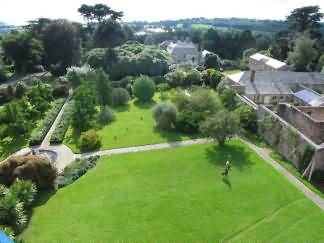
Par, St. Austell, PL24 2SJ
Tel: (01726) 814389
Email: greengene@tregrehan.org
Web: www.tregrehangarden.uk
Historical all-year garden
Tregrehan has been home to the Carlyon Family since 1565. Jovey Carlyon's passion for trees during the late 19th century is evident in the towering specimens seen today. Beneath this canopy Gillian Carlyon's (1924-1987) renowned collection of camellias flourish. In quiet rebellion against this promiscuous genus, the botanical collection of the current 'gardener' (encumbered with the same passion as his forebears) requires an appreciation of the diversity of the world's flora. At its floral peak in the spring, the twenty acre garden and magnificent green-house built in 1846 has to be seen.
In 1680 the construction of Tregrehan House was begun by Thomas Carlyon, possibly the first double-pile house in Cornwall and continued by his son, also Thomas. By 1734 Philip Carlyon, successful mining entrepreneur, also had horticultural interests selling laurels, elms and oaks in 1738 and also 'planting up the moor by the Whitewater with 264 trees, larch, fir, walnut, chestnut and beech'. Philip's son died childless leaving the estate to his nephew Thomas IV (1770–1854). Zenith of the families wealth and influence rapidly growing on the back of the Industrial Revolution. This had the greatest effect on the landscape and house and firmly established the family in society. The barns and a dairying complex were developed with some ornamentation fashionable at the time. Thomas's son William built the Stable block and may have started conifer planting. His younger brother Edward Carlyon, who bought Greenway on the Banks of the Dart, inherited Tregrehan on his brother's early death in 1841. William suffered some form of dementia in his final years and was labelled a lunatic. Colonel Edward Carlyon moved with his family back to Tregrehan following a complete refurbishment of the house and landscape. Architect George Wightwick redesigned the house as a stately home in 1842 in classical style with Ionic colonnade.
In 1844 the walled garden was remodelled to become one from two separate gardens and the extensive glasshouses stretching 128 feet were erected.
In 1845 Edward Carlyon employed noted garden architect William Nesfield and together they designed the entrance court, parterre and probably the Yew walk. Nesfields involvement in the wider landscape is uncertain. However the design followed his intentions with major view lines running from the parterre in picturesque tradition with ill defined park boundaries, creating an illusion of infinity. Before Edwards death he gave the land and paid for the construction of the church and steeple at St. Blazey which form the Bastion view. He created the formal drive to the beach at Crinnis and negotiated the construction of the ornamental bridge with the Cornwall Railway.
By the 1850's Thomas Tristrem Carlyon (1822-1884) attached the ornamental piggery to the southern side of the barn which survives today as a courtyard garden.
From 1880 to 1894 Jovey Carlyon continued with the planting of his grandfather (his father George emigrated to New Zealand) and founded a large part of the present collection. Over thirteen nurseries supplied the garden in the 1980's, with records of species type, provenance, position and sometimes condition.
In 1914 Professor Sargent of the Arnold Arboretum stated " Tregrehan is the best thing of its kind in the world"
During 1916 W.J. Bean visited from the Royal Botanic Gardens, Kew and published a detailed article about 'The Arboretum at Tregrehan', noting fine examples of rhododendrons and was especially taken by the conifer collection.
In 1935 the Carlyon family was absent from the estate when Rupert Carlyon, Jovey's nephew, returned from New Zealand. Rupert imported a large amount of material particularly the newer rhododendron hybrids.
During the 1960's Gillian Carlyon (Rupert's daughter) began a major camellia breeding programme producing many of the hybrids still in collection today.
When Tom Hudson, cousin of Camellia Carlyon, took over in 1987, the garden was listed as nationally outstanding on the English Heritage garden's register. With Tom's additional layer of planting from the southern hemisphere sprouting amongst historical species dating back to the 1840's, this truly is history and horticulture at its best.
The ailing 150 year old greenhouse range was restored and the glass roof reinstated along with many of the timber sashes. The main beams and internal dividing sections remained in good order, a testament to the quality of the original close-grained timber.
Just off the A390 two miles east of St. Austell.
Shop and facilities:
Tea, coffee and snacks available.
We do not supply lunches but you can bring your picnic basket.
WC suitable for disabled.
Parking for cars and coaches.
No dogs in the garden.
Opening TimesMid March - End May June to end August Admission Charged |
Par St. Austell Marsh Villa Gardens Pine Lodge Gardens The Eden Project Kidzworld Par Market